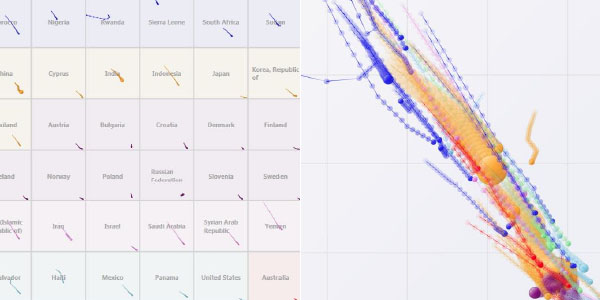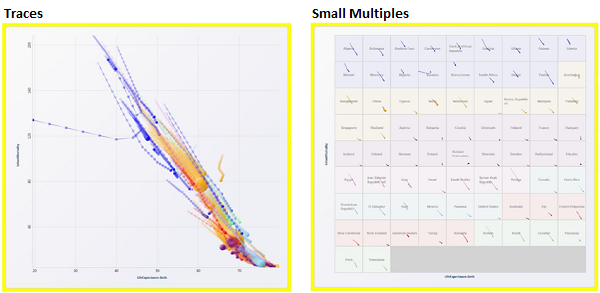Animation efficiency when representing temporal trends.

Since the first appearance of GapMinder , animation, as a way of displaying trends and patterns when displaying complex data, has gained more popularity than before. It seems that people want to show more and more bizarre animations a la Gapminder, in their presentations, and an increasing number of new products on the market that are trying to copy this visual style.
Without a doubt, the data-driven animation in rendering is great. People seem to like it a lot. As a result, powerful animation features have been incorporated into many popular software packages. But does animation allow people to better perceive complex data?
Several researchers from Microsoft Research and Georgia Tech. explored this issue in InfoVis 2008 and presented the results in a document titled “ Animation Efficiency in Trend Visualization ” (PDF). The short answer to the question posed is depending on the situation.
Scientists compared 3 different data visualizations based on historical data for UN countries. They measured their effectiveness in terms of accuracy, speed, and subjective satisfaction with the result.
Animation: standard plot with animated bubbles.
Small networks: a static section of the matrix, where each point represents one and shows the evolution of bubbles (countries) from the initial to the final position. (bottom right).
Footprints: One standard (static) visualization scatterplot, on which footprints are drawn over each other. (bottom left)

')
The animation leaves no traces, but simply animates the transitions.
The study interestingly distinguishes between two goals of visualization: presentational and analytical, and is designed to compare the performance of each of them. Accordingly, the answer varies depending on what was the purpose of the visualization.
Here is a summary of the main findings:
- Small networks have always been more accurate than others.
- The animation was the fastest in the presentation (60-70% faster).
- Animation was the slowest in the analysis (from 50 to 80% slower).
- People found the animation more interesting, and they liked it.
But when asked about which technique they would prefer, there was no clear winner.
So, what did you learn with this? And how can this be translated into practical recommendations? Here is a summary of the findings of scientists:
- The difference between the objectives of the presentation and analysis: the same technique can not be equally effective for analysis and presentation. For different purposes, different solutions are needed.
- Animation can be adequate and interesting for presentation purposes: animation is suitable for presentation. In particular, if you want to get the effect of participation in the presentation, the animation will help create the effect of empathy.
- You should not expect from the audience that it will understand all the details: the study showed that people can get confused very easily, and the overall accuracy of data reading in each case was low, regardless of the technology.
- And you need a good speaker and a minimum of data: good interaction with the audience depends heavily on the speaker’s qualities. GapMinder works great primarily because its creator is a brilliant speaker. A perfect technician will not be able to hide the flaws of a bad speaker. In addition, the audience may be slightly overloaded with data. Do not expect the effect on a large amount of data to be equally successful.
The problem of animation goes far beyond the scope of one study. Some researchers predict its limited and narrow application, while others are more optimistic.
One of the areas where the animation will have advantages is the visualization of transitions between visualization states. Some use animation as a way to convey complex concepts. But the result in this case is controversial. Finally, the study of animation in an environment where dynamic data is visualized is certainly noteworthy and will require much more research.
Animation is well distributed and perceived on the Internet. Surely, designers use animation only when they consider that it will work to achieve a brilliant result. However, the animation has a strong effect on the viewer, and you should try to use this advantage as much as possible. It would be nice to see more research like this in the future.
Source: https://habr.com/ru/post/105193/
All Articles